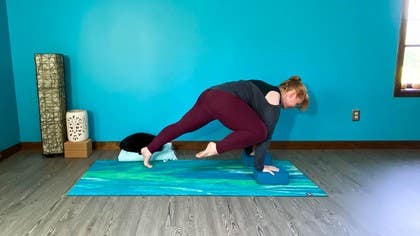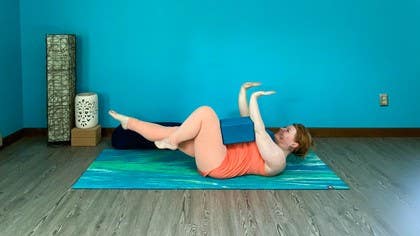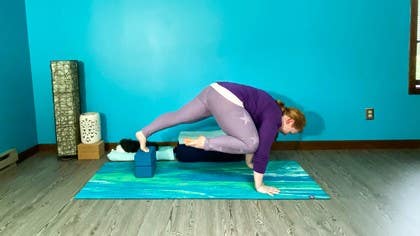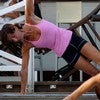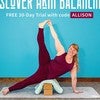Description
About This Video
Transcript
Read Full Transcript
Hi, everyone. Welcome back. Today we'll be taking a look at the pivotal role that your hips play during arm balancing. So they can help to serve, create a sense of lightness in your arm balancing practice. They can help you to identify when you're shifting in space. And there also can be your center of balance, your center of gravity when you're arm balancing. So today we're going to explore different hip postures as they relate to the Bakasana family. So let's get started. You're going to need two blocks, a strap and a blanket. So come on down onto your back with your block. And you'll take your block and place it between your inner legs so that the block is parallel with your thighs. And as you come down, if it's uncomfortable at all, make any adjustments. Straighten your legs and now squeeze the block. So as you're squeezing the block, try not to have the buttocks involved very much so that you're concentrating more on the pelvic floor. And your pelvic floor muscles, they connect from your pubic bone to your tailbone. And then there's sort of this widening effect that goes on. So they branch out towards the inner true pelvis. So it's almost like this hammock of muscles that you have. Okay. And then release the squeeze. So again, hug the block. Okay. So you'll feel tone at the inner thighs for sure. But then there's this slight lifting sensation inside of your pelvis. So those are the pelvic floor muscles that lift and then release. So when we talk about the role that the hips are playing and that sense of lightness, this is where that lightness comes from. Hug it. Pelvic floor lifts. So now keep the pelvic floor lifting. You might even notice yourself sort of adjusting on the mat getting longer in the torso. As you're hugging in, think of your inner knees and push your inner knees slightly out. And then maybe you'll get some tone in the quadriceps and also in the outer hip. So tops of the thighs, outer hips and release. We'll do that one more time. Squeeze the block. Inner thighs engage. Pelvic floor lifts. Find that sense of lightness. And then there's a sense of steadiness as you press your inner knees out to the sides and the quads and the outer hips engage. Very balanced feeling around the hips.
And then release. Okay. From here, move your block aside and we'll come into standing marches. So both of the knees are bent. Lift your right knee up. Try to keep the right leg from turning out to the side. And then place the right foot back down onto the floor. Lift the left thigh up and release. Place your hands where they feel comfortable. Lift the right leg and then the left. I just noticed the quality of the movement as you march in place. Is it smooth? Okay. Do you hear popping going on? What's that adventure like? Okay. Now hover your left foot away from the floor. Imagine as though you were still squeezing that block and turn your inner thigh in. So you're internally rotating your left thigh. You may feel some activity happening at the hip crease and at the outer hip as well. Swing the heel back through center and place the foot down. Lift your right foot up. And again, internally rotate the right leg. So the heel moves towards the long edge of your mat. And then release. Place the right foot down. Do that one more time, but try to alter the height of the foot, right? So if you picked your foot up a lot, bring it closer to the mat. You know, maybe the next time you lift the heel up a little bit higher and then internally rotate your left thigh. So I noticed that the higher I lift my leg, the less internal rotation I have. And I don't have very much internal rotation. So that's good information for me to understand about how my body moves. Okay. And then bring the leg back and settle the foot down. Switch sides, lift your right leg up. Okay. Find a different height between your foot and the floor. Internally rotate. And as you're internally rotating, right? You may notice that the engagement of the outer hips feels different. This go around because you've changed the height between the foot and the floor. Okay. Keep pulling the heel out to the long edge of your mat. Bring the leg back down one more time. Okay.
So go to that place where you felt like you got the benefit, the most benefit out of your internal rotation. Okay. Hold the leg there. And you can play in space, right? So I noticed the lower down, the more I can feel, I can connect with. Okay. And place the foot back down. Other side. Lift the right foot up. Swing the heel out to the side. Keep your breath steady. Good. And then lower the right foot back down to the floor. Now you're going to retest that march. Lift your right leg up and place the right foot down. Did you notice a difference? Okay. So you might actually be able to bring the thigh a little bit closer in towards the chest, but also the way that the thigh moves at the hip joint may feel vastly different. So when you think of your arm balancing positions, we're looking for deep hip flexion. Okay. Where your thigh comes closer to your chest and that we might need to pay a little bit of attention to that internal rotation, that active internal rotation in order to find such a quality in our hip movement. Good. And then place the right foot back down onto the floor. Roll to one side and come on up onto all fours. So do the same thing. This time in tabletop. So you'll lift your right foot up, swing your right heel out to the side without your hip going along for the rise. So notice if the right side waist feels like it's more cramped. Okay. If that's the case, back off, put the foot down, even out the sides of your waist and try again. Lift the heel, pull your right hip back as you spin your right thigh in, pull your right hip back as you spin your right thigh in. And you may notice some bouncing happening at the thigh and the foot. Okay. And back through center. And again, lift the left foot away from the floor, tack your left hip back, spin the left thigh in any amount and back through center. Okay. Now imagine you're squeezing the block between the inner thighs. So like you have that lift of the pelvic floor. Perhaps there's a lengthening action happening along the spine. Hug, lift, rotate. So you're rotating your inner right thigh in as you continue to squeeze the inner legs in towards each other. Good. And then release the right foot down, switch sides, left foot up, spin the left heel out to the side, squeeze the inner legs in together. Take another breath here and back through center and release the left foot down. Okay. We're going to retest again. Grab your strap and come on down to your back. Okay. Rest your hands comfortably and slowly draw the right leg in. Does that feel different? Okay. Place the right foot down, switch to the left, draw the left leg in and back down. One more time to each side. Good. And then release your left foot down. Bend your right knee into your chest as you grab your strap and loop the heel of your foot. So you can make a loop or spread your strap out and hold onto the tails of your strap. Straighten your left leg forward for Supta Padangusthasana one. And as you reach your right heel up, again, think about that idea of tacking the hip back or pulling your right hip toward your left heel. I'm going to take this into a little bit of a twist. So inner thighs hug, hold onto the ends of the strap with your left hand and bring the right leg over the left side of the body, allowing the left leg to turn out. You can go all the way down to the floor. You can hold it at about a 45 degree angle. But if you come all the way down, you're going to roll all the way over onto the outer edge of that left foot as you start to make your way down. And slowly come on up. Bend your right knee and slide your right leg forward. Switch sides, bend your left knee, loop the heel of the foot. Straighten your right leg. Pause here for a moment. Continue to activate. So the inner thighs hug, pelvic floor lifts, and perhaps you can add a little bit of the opposite action of pressing your inner knees away from each other to create that balanced sense of support at your hips. Take your right hand to hold both ends of the strap and move your left leg to the right. Roll over onto the outer edge of the right foot. I have the wall so I can rest my foot on the wall. And reach your left arm out to the left. Hug your inner legs. Feel the lift of your pelvic floor. Maybe press the inner knees away from each other. So it gives you a sense of all these different qualities that you can create in your hips. Okay, and then inhale, come back through center. Bend your left knee, place your left foot down onto the floor, followed by the right. Okay, roll on over. And let's make our way into downward facing dog. Have your blocks and set them up at the top of the mat so that they are ready for you. Okay, tuck your toes under, lift your buttocks up and back, press back through the legs. Down dog. Okay, and even here, notice that deep hinge at your hips. Okay, maybe you can increase that, bend your knees and straighten the legs.
Maybe open the legs out a little bit wider to the sides and turn the legs out just slightly. So it's almost like that bakasana squat. Let the heels lift, bend so the torso moves towards the inner thighs, maybe past the inner thighs. And then straighten. Okay, walk the feet back through center. And now walk your feet up to your hands. You can crawl your hands onto your blocks and change the height of the blocks as you come up to stand. Okay, release over the legs. From here, take your hands to your hips, press down through your feet. Try a little bit of that action, hug the inner thighs in, push your inner knees out, pull your chest forward, and then the knees can still bend here as you're doing those actions and come all the way up to stand. Okay, so now recreate those actions, hug your inner thighs in, feel the lift of your pelvic floor, press the inner knees out. Take your hands to your hips, bend your knees, fold at your hips, and then keep bending your knees as you fold. Deepen at your hip crease. Take your hands to the floor to your blocks. If your hands are on your block, slide the blocks back so they frame the outer edges of your feet and step your right foot back into a lunge. Okay, from your lunge, have that same sense of pulling the inner thigh in towards your midline, pressing the knee out to the side. Take your left hand, place it underneath the back of your left thigh, and imagine you're scraping your left heel back so that you can feel the belly of the hamstrings engage as you pull the left heel back in space, like you're scraping gum off of your foot. Okay, then place the left hand back down onto the block or floor and step your right foot forward. Come to the other side, bend your knees, look forward, hug and press, step your left foot back. Okay, then from here, take your right heel, isometrically drag the heel back. And now step your left foot forward. Again, take your hands to your hips, push into your feet, come all the way up to stand. So now we're going to add to that sequence, shift your weight over to your left foot, lift your right leg up. So think of that compact shape. And then if you want to find a standing ikapada bakasana, bring your hands forward, bring your elbow to your knee. Then from there, you can drop the foot down the hands down and step back to your lunge or bend your left knee very slowly start to step back. Okay, the right leg is going to shift back, hands will touch the block or the floor. But now you switch. So take the left elbow to the front of the left knee, and the right hand out in front, push forward as you press back into your right heel. Okay, and then lower your hands and step your right foot forward. Hands to your hips, lift the chest up, inner thighs hug in as the pelvic floor lifts, and come over to the left side. So shift your weight over to the right foot, lift your left knee up, okay, stay here or come forward. Bring the left elbow to the front of the knee, you can even bring the hand to the knee instead. Okay, then from there you have your options. Bend your right knee, start to step your left foot back as your hands make contact with the blocks. Okay, right elbow to the front of the right knee, left hand in ikapada bakasana arms. Pull the right heel back. Okay, place your hands on the blocks, step your left foot forward. Okay, from here, bend your knees, look forward, step your right foot back, spin your right heel to the floor, cartwheel your hands up coming into warrior two. This time for your warrior to think about pulling your heels in. Okay, so you'll feel that as you pull your heels in, the trunk of the body rises. Okay, those pelvic floor muscles are helping to create that sense of lightness here. Take your arms out to the sides. Okay, from here, cartwheel the hands down. Take your hands to the inside and place your blocks on the lowest height. So scoot your left foot out to the side. Come on to the ball of the right foot. Then from here, just for fun, press into the hands, lift your left heel up. And then maybe can you pull the left heel back like you were doing in lunge and lift the left foot up, left foot back down, walk the foot in frame the foot with your blocks and step your right foot forward. Then your knees look forward, step your left foot back, spin your heel down, cartwheel your hands up warrior two, and then play. Hug the heels in together. Okay, push your heels away from each other so you can feel the difference, right? Doesn't the body lower? Hug in, press out. And again, hug in, cartwheel your hands down, rise up onto the ball of your left foot, walk your right foot out to the side, blocks on the lowest height. Okay, you find the knee to the back of your right arm, lift the heel, and like you were doing in your lunge before, now it's not isometric. Now you do it, drag that heel back. And now place the right foot back down to the floor, walk your right foot in as you take the block to the outside of the right foot, step your left foot forward, take both of your hands to your hips, bend your knees, hug your inner legs in, press your outer knees out, pull the chest forward and come all the way up to stand. Okay, so from here, take your blocks and set them up onto the tall height. And this will be very much like a kapada bakasana, another standing version. Okay, so hinge forward at the hips, okay, feel the quality as you come into hip flexion, hands come onto the blocks, shift your weight into your left leg, bring your right leg up like Virabhadrasana three or warrior three. Okay, then from here, bend your right knee, you can point your toes, pull the right knee in, and bring it as close to the right upper arm as possible. And then bring the leg back out, pointer flex, then bend the knee in. This time, as you draw the knee in, notice where the knee is in relationship to your arm. Lift your left heel up, does your knee lift up higher, lower the heel down, and send the right leg back. One more time, knee comes towards the arm, lift up onto the ball of the foot, maybe that knee comes up a little bit higher. Drop the heel down, this time step your right foot next to your left foot. Take your hands, flip them over, give them a little break. So you can see that as you're shifting and as you're moving, the hips help to guide you as you balance, and they'll do the same thing in the arm balance. So it's nice to have more of a frame of reference being on your feet and moving your legs, moving your hips, then when you're in the arm balance and learning those same motions. Okay, hands back out front, this time shift your weight over onto your right foot, send your left leg up and back. Okay, then from here, bend the left knee in towards the left arm, and back out. Knee towards the back of the arm, stay here or lift the right heel up. And then drop the heel, press the leg back, can point the toes, right? Bend the left knee in, maybe lift the right heel, and then send the right foot down, left foot down, and release. Okay, and again, maybe take the elbows out to the sides, palms face up in the back of the hands to the ground or blocks. Open up your feet just a little bit. Okay, turn the toes out, bend and straighten the legs, pull the chest up, accommodate as you need. You start to approach towards your squat. Okay, and then from there, you make your way onto the floor as you wish. And take your blocks, you create a block bench, sit on your block bench, take your legs out in front of you, bend your right knee, placing your right foot onto the floor, take the left hand in front of the right shin, the right hand behind you, and turn. Okay, so this idea that when you are moving your legs in the hips, that you're not using your hands to do it. So from here, you're going to take your left leg and pull your left leg in, and then step your left leg forward. Then maybe you stay here, you take the elbow to the thigh, you can cross to the outside of the thigh, okay, you don't even have to touch, you can have more of an active twist. And the same thing, pull the leg in, squeeze the inner legs, feel the pelvic floor lift, and then send the leg back out. Parjbha bhakasana, right, seated version. One more time, hug the inner legs, twist a little bit more to the right, send the left leg forward, unwind from your twist, send your right foot forward on the other side, bend your left leg, try not to pull your left leg in, right? So all the actions that we worked, bending the knee, pulling the knee in like that march, and stepping the foot down. Okay, take your right elbow to the outside or hug the leg, left hand behind you, turn to the left. Okay, and then can you pull that right leg back, that hamstring contraction or the scraping of the foot, and send it forward. Then if you want to try the arm balance arms, and pull the right leg in, hug the inner legs, right? So before I was collapsing and then I hugged the inner legs in, pelvic floor lifts, and it helps me to rotate a little bit more. Step the right leg back out one more time, draw in, hug the legs, lift the pelvic floor, turn, right foot forward, unwind your twist, and step your left foot forward. Okay, let's come on down. Move your blocks to the side for a moment, make your way onto your back. Take your arms out to the sides to a T, open up your feet about as wide as the mat, a little windshield wipering of the legs from side to side. As you're ready, come back through center, lock your feet in, bring your legs forward, arms down by your sides, and come into shavasana. Let your hips settle into the mat, and notice the connection between the lower and the upper body. So if you think of your arm balancing, particularly with the bhakasana family, when the upper body is steady, that's when the hips have this unique opportunity to connect with the lower body, to help us sense where we are in space, to keep us centered, and be able to move into these different shapes and explorations. And deepen your breathing. Wiggle your fingertips and toes. And you're ready to go. You're ready to move your hips and toes. Slowly bend your knees in towards your chest as you roll to one side. Support yourself on your side for a moment. And when using your hands, press yourself up into any comfortable seated position. Bring your hands to your heart, gently draw your chin towards your chest. And thank you for practicing with me, and I'll see you next time.
Discover Arm Balancing: Bakasana & Family
Comments
You need to be a subscriber to post a comment.
Please Log In or Create an Account to start your free trial.

